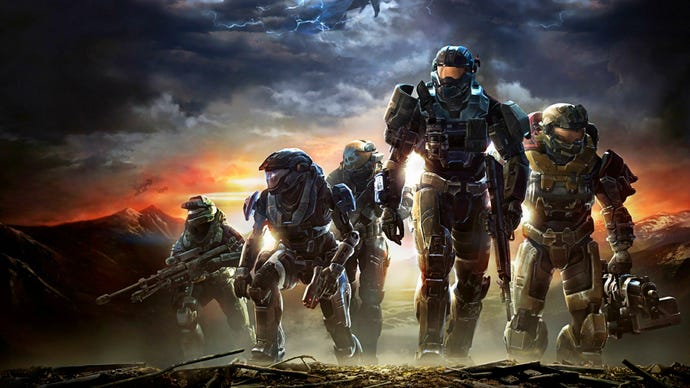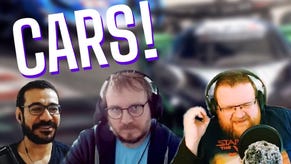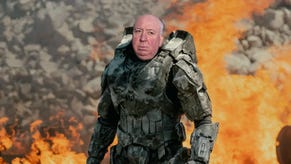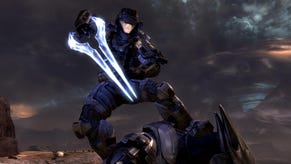The Making of Lone Wolf, Halo: Reach's Famous Final Mission
The story of Halo: Reach's last stand, and why it was controversial even within Bungie.
This article first appeared on USgamer, a partner publication of VG247. Some content, such as this article, has been migrated to VG247 for posterity after USgamer's closure - but it has not been edited or further vetted by the VG247 team.
Current Objective: Survive. After successfully getting Cortana to the Pillar of Autumn in Halo: Reach, this was the reward. With waves of Covenant forces still landing, you're entrusted with one last mission: ensuring Noble Six received the hero's death they deserved.
"Lone Wolf" is the poignant epilogue to Bungie's time as Halo's custodians. As the screen fades on the Pillar of Autumn approaching a Halo ringworld, we rejoin Noble Six standing on a platform watching the covenant roll in. There, standing on the metaphorical edge of existence, the mood is light, upbeat even, because the important part is done. Covenant Elites may have Six's life, but they don't have the war, and in your own little way you're about to remind them of the sheer tenacity and perseverance they're up against. Dramatic and melancholy, the stage gives players control over Six's final stand. It now serves as a monument to a development team given the remarkable chance to bid farewell on its own terms.
"I thought of Halo 1 through 3 as the old World War II movies, like Battle of Midway and Tora, Tora, Tora—these big grand stories that show the overall scope and the fleets and the generals," Halo: Reach lead designer Christian Allen tells USgamer. "One of the things that we talked about a lot was the idea that Reach was more Saving Private Ryan—it was about this small squad in the middle of this big thing. And, if you look at Saving Private Ryan, you can see a lot of the similarities; you got this team of different characters, and they all slowly drop off one-by-one."
Always intended to be Bungie's last hurrah with the Halo universe, Reach was developed in tandem with Halo 3: ODST, a spin-off of the main trilogy focusing on the UNSC soldiers that fought alongside Master Chief. Whereas ODST was intended to spotlight all the unsung little victories that go into any ongoing military effort, Reach was decidedly more grand and sweeping. The environments were larger, and you played as a group of Spartans called Noble Team. Coming from Tom Clancy's Ghost Recon, Allen was keen to offer players a similar tactical openness within the standard Halo paradigm.
"We talked a lot about providing players with multiple choices and different avenues," he says. "That scale came down from Ghost Recon to Halo; that feeling of player choice and player empowerment, and a little bit less of an on-the-rails experience, while there is still some of that. Especially just the fact that there were more Spartans there with you, to make it feel like you were fighting as part of an army."
Himself a U.S. Army veteran, Allen focused on military accuracy. The ground-level troops on Reach are the UNSC Army—an occupying force, rather than the shipboard UNSC Marines that are commonly found in other installments. Noble Team are officers, as opposed to being enlisted soldiers like Master Chief. Their costumes reflect their roles within the group; for instance, June has the appropriate pouches and veil to be a sniper. Their guns and knives are inspired by present day equivalents around the world, such as Emile using an Indian blade called a "kukri," and new vehicles reflecting the lumbering, armor-heavy American army transport of the 2000s.
All of this underpins exactly why "Lone Wolf" is so effective—it's a fitting end to an authentic-feeling story. In contrast to Master Chief's silent one-man-army blasting through all adversity, Halo: Reach follows a platoon that needs each other if they want to succeed, and slowly die as they inch closer to completing their mission. They have their own voice and personality, making their potential survival a genuine concern. In a series that's not always consistent with its wartime allegories, Reach hits the hardest in the way that it makes you complicit in the sacrifice Noble Team are forced to make.
Halo aficionado and content-creator HaloFollower, whose regular news updates, canon deep-dives, and more have drawn over 650,000 subscribers on YouTube, views Halo: Reach as an inversion of Master Chief's power fantasy. Where the latter has one hero blasting through three games, the former has several, and none of them get out alive. "It's like, you're all dying, but it's kind of meaningful," he says. "With Master Chief, he's going to win at the end of the day. Things might go south, but ultimately, let's finish this fight."
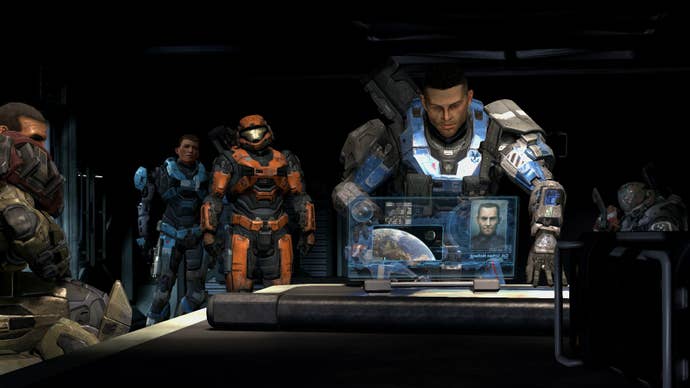
This disparity made the leap from Halo 3 to Halo: Reach somewhat jarring, believes HaloFollower, who mentions that a general shift in gameplay and tone puts it in a class all its own makes it an odd duck among the Spartan entries. "We used to only have to worry about shields, but now we have to worry about health, which would reduce in things like fall damage," he says. "It just added a whole new mechanic that people weren't used to. We were now playing as Spartan-IIIs, and Noble Team was so different from Master Chief and Cortana, that charming duo that just wasn't there."
On the other hand, the altered narrative complexion opened up Halo's lore in some fascinating ways. We got to see the underbelly of this far-flung future war, in which, two centuries from now, we're still not as powerful as we'd like to be. "[It reveals] exactly what happened with the Spartan-IIIs and the dangers of being a Spartan, even though you're one of the most powerful humans alive in the suit. So it makes humanity feel even that much more vulnerable," HaloFollower explains, adding that tie-in novel The Fall of Reach goes even deeper on the surrounding military industrial complex. "We learn about what happened with the Spartans, and exactly how it was to be raised in military life as a child."
Noble Six Makes the Ultimate Sacrifice
In the end, Noble Six is forced to make the ultimate sacrifice. Ending on such a somber note was contentious within the development team. They knew they wanted to lead straight into Halo 1, but that still left the question of what ultimately happened to Six. Several ideas for a conclusion were bandied around, including variations on an ambiguous fade, until a prototype of a play-until-you-die level made the rounds. Some felt having the player-character be killed invalidated the narrative, but Allen and others knew this made the most sense in the way that it brought everything full circle, back to the player fighting for their lives against the onslaught. It wasn't an easy sell, but eventually everyone came around.
"It was very controversial the entire time that we were actually going to do it, and there was a lot of 'well, maybe we could drop hints', maybe we show someone walking off, or maybe there's a radio call from June, 'Oh, Noble Six, I'm coming to get you' or something like that," Allen says. "Of course, marketing freaked out, they were like, 'Well, how are we gonna do a sequel to this if you kill the protagonist?' This is credit to Bungie for sticking to the guns of making that hard decision that makes the whole story really come together and really validates it because you've got all these sacrifices."
Although the game puts you back in control, there's only ever one way it concludes, and getting the exact nature of the climax right took sizable fine-tuning. Your visor cracks as you get hit, suggesting this damage won't be healing like the rest. The Covenant onslaught is overwhelming. That you might be able to outlast this challenge lingers in the back of your mind, until the Elites start to get the better of you and you take off your broken helmet. It takes three of them to finish you off for good—a poetic demise fitting of your prowess as a Spartan.
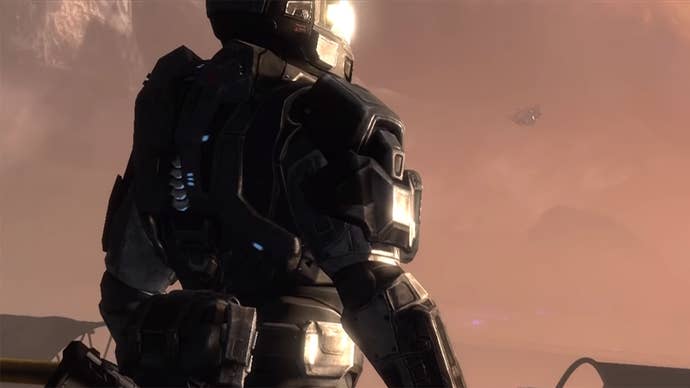
"The mission designers spent a lot of time just tweaking, especially the end sequence with the helmet coming off and the power swords and everything," Allen says. "It's really empowering. I think it ranks up there with the guy from Platoon, when Willem Dafoe goes down, and a few of these characters that you see die in movies. It's like, 'Oh, okay, well, they really did their thing, they put everything into it', and that's the feeling that I think the mission designers really pulled off with that."
The climax isn't without its inconsistencies. Noble Six could have gotten on the Pelican that was leaving, but instead decides to die on the same ground as their team. It's a noble piece of character-work (pun intended), and something that Allen says was argued over many times, along with how obvious it would be that the package was actually Cortana. The finished product is a result of compromise, and though effective nonetheless, there was room to be a little more succinct. "I just wish that maybe the Pelican was shot or something," HaloFollower muses. "He could have escaped and it just made sense for them to leave without him, because he could have totally got on."
Of course, over the years, players have found ways to delay the inevitable. One discovered an exploit involving a makeshift fort that allowed them to last indefinitely, and now that Reach is out on PC, more glitches are sure to emerge. Modders have already created a cavalcade of add-ons and touch-ups, including a graphical overhaul that essentially remasters the game. HaloFollower is producing a fan-series, Lone Wolves, that follows a second team on Reach, using Xsens motion-capture, the same software used by EA and Ubisoft. Part sidequel, part pitch for what a return to Reach could look like, the show's taking some liberties with Bungie's canon, namely in that Noble Six makes a brief appearance in the first episode.
Allen recalls diehard fans going through the full wave of emotions at launch as they ingested the game as quickly as possible. The whole project was a rarity; Bungie were given full time and resources to finish their tenure on a beloved franchise, and they went out with guns blazing. "Lone Wolf" may not be a happy ending, but it is a memorable one.
"I remember it being a positive experience, of sadness, and emotion. People were like, 'This is sad. It makes me sad, and I'm not happy because it makes me sad,'" Allen says. "I don't remember a lot of 'This is stupid, this feels corny, or lame.' It was like a good action or war movie, you know. You're not happy when Tom Hanks dies at the end of Saving Private Ryan, but it sure makes it a hell of a much better movie, right?"
